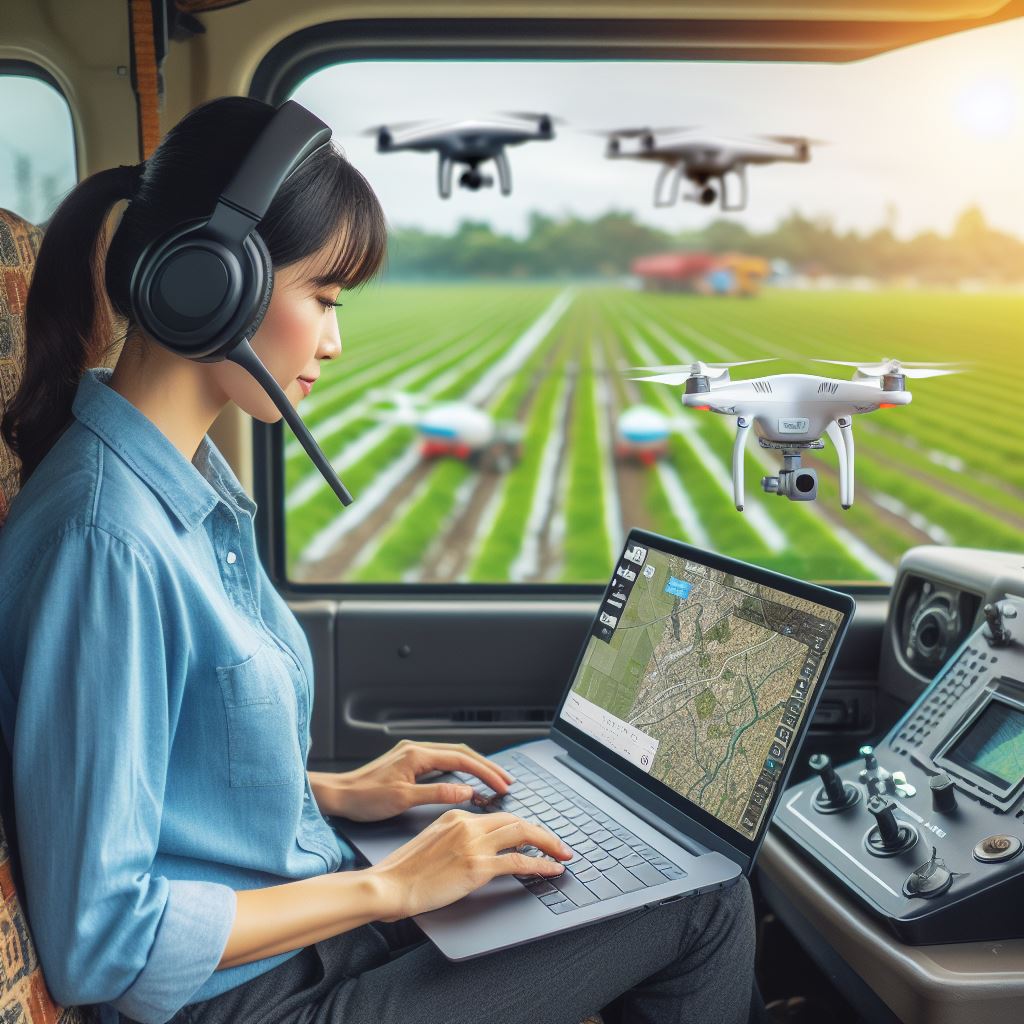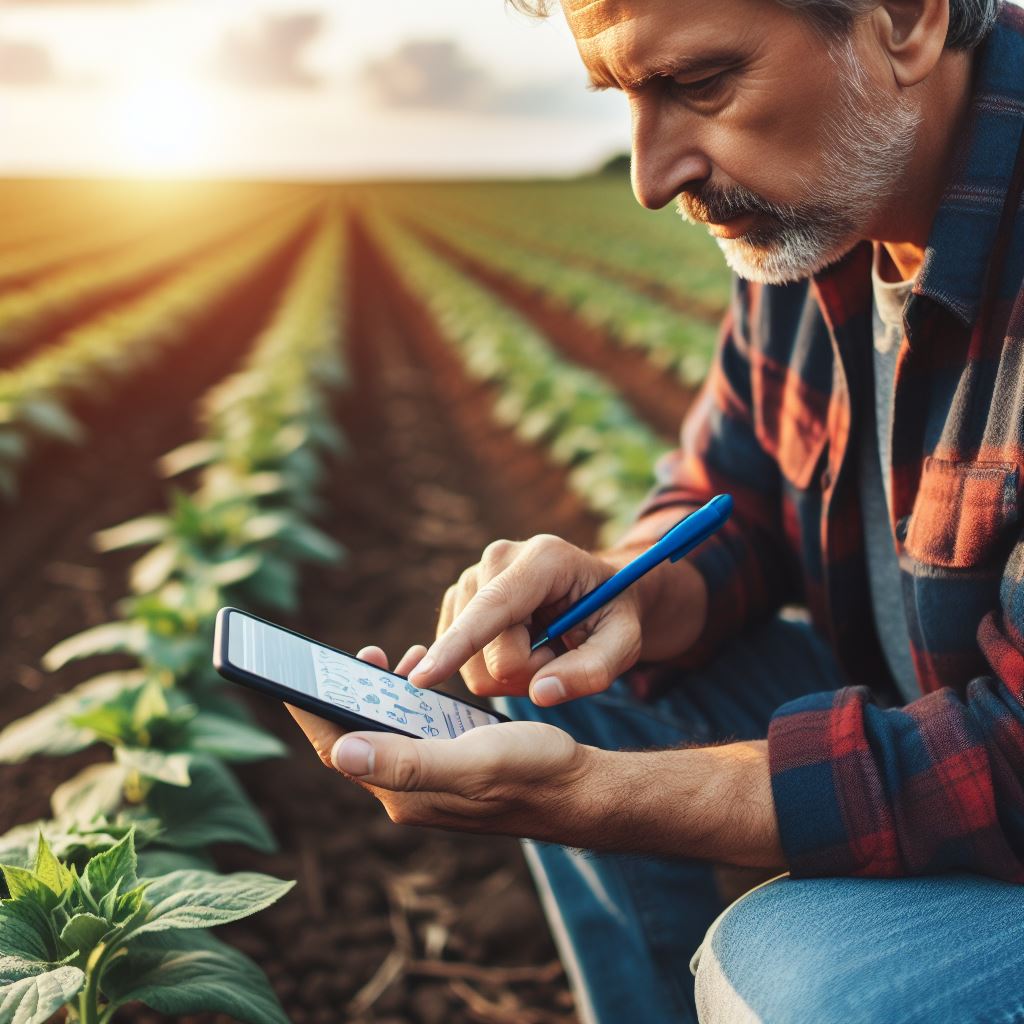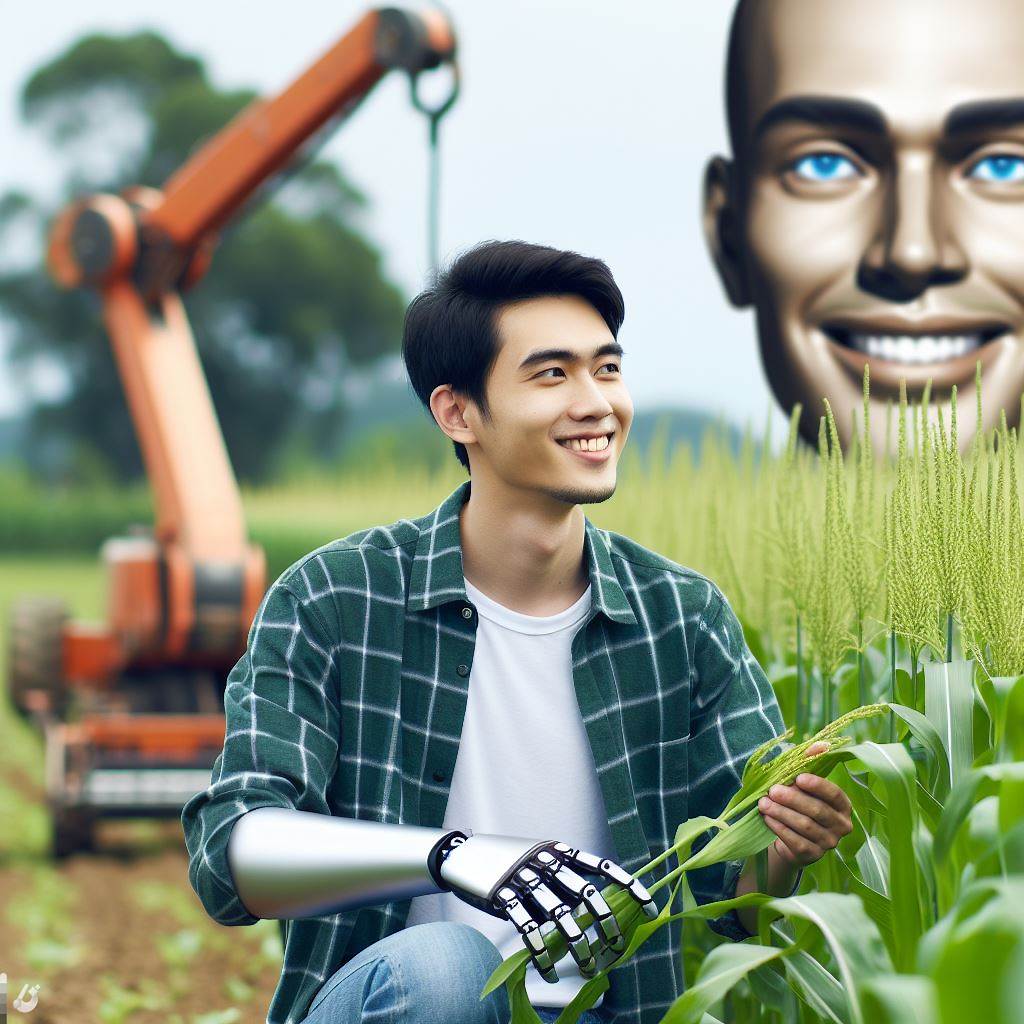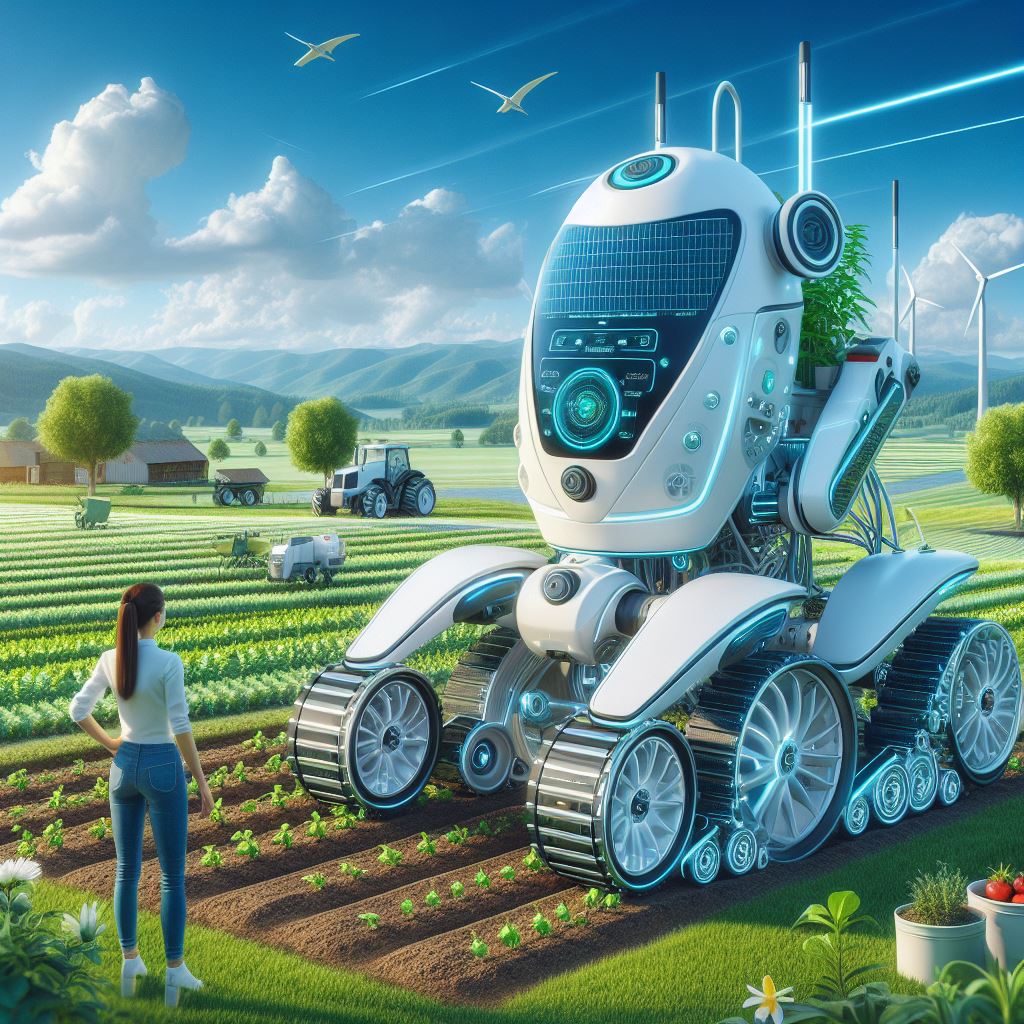Introduction
Drone technology has revolutionized various industries, including agriculture, with its potential for cost-effective and efficient operations.
Drones, also known as unmanned aerial vehicles (UAVs), are aircraft without a human pilot on board.
They are remotely controlled or can fly autonomously based on pre-programmed flight plans.
The importance of drone technology in agriculture cannot be overemphasized.
Drones provide farmers with a sky-high view of their crops, enabling them to precisely monitor and assess their fields.
This aerial perspective helps detect early signs of disease, nutrient deficiencies, or pest infestations that may be invisible from ground level.
With high-resolution cameras and sensors, drones capture detailed images and collect data on crop health, moisture levels, and temperature variations.
This information allows farmers to make data-driven decisions, optimize resource allocation, and minimize the use of pesticides, fertilizers, and water.
Moreover, drones equipped with infrared sensors can identify irrigation issues, locate leaks, and prioritize irrigation needs.
This data-driven irrigation strategy promotes water conservation, reduces costs, and maximizes crop yield.
Drones also aid in surveying vast farmland, creating accurate topographic maps, and monitoring soil conditions.
Such data helps farmers create precise planting patterns, implement efficient crop rotation strategies, and improve overall soil fertility.
In short, drone technology plays a crucial role in modern agriculture by providing an aerial perspective, capturing valuable data, and enabling farmers to make informed decisions.
Integrating drones into farming practices enhances productivity, reduces expenses, promotes sustainable practices, and ultimately contributes to global food security.
Benefits of Drones in Agriculture
Agriculture has come a long way in recent years, and one of the most exciting advancements in the field is the use of drone technology.
Transform Your Agribusiness
Unlock your farm's potential with expert advice tailored to your needs. Get actionable steps that drive real results.
Get StartedDrones, also known as unmanned aerial vehicles (UAVs), offer numerous benefits to farmers and have the potential to revolutionize the way crops are grown and monitored.
Here are some of the key advantages of using drones in agriculture:
Efficiency in Crop Monitoring
- Drones equipped with specialized cameras and sensors can provide real-time data on crop health.
- By flying over fields, drones can assess plant stress, identify diseases, and detect nutrient deficiencies.
- This allows farmers to address issues promptly and prevent crop loss, resulting in higher yields and better quality produce.
Improved Crop Yield and Quality
- With the help of drones, farmers can optimize irrigation and fertilization practices based on precise crop data.
- By monitoring variables such as soil moisture levels and nutrient content, drones can ensure crops receive the right amount of resources.
- This leads to improved crop yield and quality, as plants can grow in optimal conditions.
Cost-effectiveness and Reduced Labor
- Drones streamline agricultural processes and reduce the need for manual labor.
- Instead of manually inspecting fields, farmers can rely on drones to gather valuable information quickly and efficiently.
- This saves time and reduces labor costs, allowing farmers to allocate their resources more effectively.
Precision Agriculture Techniques
- Drones enable precision agriculture techniques, which involve applying inputs with a high level of accuracy.
- By using drones to precisely target areas in need of irrigation, fertilization, or pest control, farmers can minimize waste and environmental impact.
- This precision helps optimize resource allocation and promotes sustainable farming practices.
In fact, the use of drones in agriculture offers several benefits that contribute to increased efficiency, improved crop yield, cost-effectiveness, and the adoption of precision agriculture techniques.
As this technology continues to advance, it has the potential to transform the agricultural industry, making farming practices more sustainable and productive.
Farmers who embrace drone technology stand to gain a competitive edge in the ever-evolving world of agriculture.
Read: Livestock Tech: Innovations in Animal Farming
Types of Drones Used in Agriculture
Agriculture has come a long way from traditional farming methods to embracing modern technology.
One such technological advancement is the use of drones in agriculture.
Drones have proven to be a game-changer for farmers, providing them with a sky-high view of their fields and enabling them to make more informed decisions.
In this section, we will explore the different types of drones used in agriculture, their descriptions, advantages, and suitable use cases.
Fixed-wing drones
Description and advantages
Fixed-wing drones are aircraft with fixed wings that resemble a miniature airplane.
These drones are designed for efficiency and can cover larger areas in a single flight.
Their aerodynamic design allows them to fly longer distances and stay aloft for extended periods.
Fixed-wing drones are known for their stability and are equipped with high-resolution cameras, enabling them to capture detailed images of the crops.
The advantages of fixed-wing drones are numerous.
Firstly, their ability to cover large areas quickly and efficiently makes them ideal for surveying vast agricultural landscapes.
They can generate high-resolution maps, helping farmers detect problem areas in their fields such as irrigation issues, nutrient deficiencies, or pest infestations.
Their long flight endurance allows them to monitor crops throughout the day and capture real-time data, enabling farmers to make timely decisions and take appropriate actions.
Suitable use cases
Fixed-wing drones are particularly useful for large-scale farming operations.
Their capacity to cover vast areas in a single flight makes them an excellent choice for crop monitoring, especially in fields with uniform crops.
They are also beneficial for precision agriculture, as they can generate accurate 3D maps and identify crop variations, enabling farmers to apply fertilizers and pesticides more effectively.
Fixed-wing drones can be employed for crop spraying, reducing the manual labor required for this task.
Multi-rotor drones
Description and advantages
Multi-rotor drones, also known as quadcopters, are drones equipped with multiple rotors that enable vertical takeoff and landing capabilities.
These drones are highly maneuverable and can hover in a fixed position, making them suitable for capturing images at various angles.
Showcase Your Farming Business
Publish your professional farming services profile on our blog for a one-time fee of $200 and reach a dedicated audience of farmers and agribusiness owners.
Publish Your ProfileMulti-rotor drones are equipped with cameras that provide high-resolution imagery, allowing farmers to closely examine the health and condition of their crops.
One of the primary advantages of multi-rotor drones is their agility and ability to fly in confined spaces.
They can navigate around obstacles and fly at low altitudes, which is advantageous for inspecting individual plants or areas that require detailed attention.
Multi-rotor drones also have the advantage of vertical takeoff and landing, eliminating the need for runways or large open spaces.
Their compact size makes them easy to transport and deploy, providing farmers with flexibility in their operations.
Suitable use cases
Multi-rotor drones excel in scenarios that require close-up inspection and monitoring.
They are particularly useful for small to medium-sized farms or fields with complex layouts.
Farmers can utilize multi-rotor drones to assess crop health, detect diseases, and identify early signs of stress or nutrient deficiencies.
These drones are also employed for precise spraying of chemicals or fertilizers, allowing farmers to target specific areas or plants that require treatment.
Multi-rotor drones are valuable for capturing aerial footage for promotional purposes, showcasing the scenic beauty of farms.
Hybrid drones
Description and advantages
Hybrid drones combine features of both fixed-wing and multi-rotor drones, offering the best of both worlds.
These drones can take off and land vertically like multi-rotor drones, and then transition into fixed-wing flight for longer endurance and coverage.
Hybrid drones are equipped with advanced sensors and cameras, providing high-quality data for agricultural analysis.
One of the primary advantages of hybrid drones is their versatility.
They can adapt to different flight modes and cover both small and large agricultural areas effectively.
Hybrid drones can take advantage of their fixed-wing configuration for large-scale crop monitoring, capturing wide-area images efficiently.
They can transition into multi-rotor mode for detailed inspection of specific crops or areas.
The combination of these capabilities makes hybrid drones a versatile tool for farmers.
Suitable use cases
Farmers can use them for comprehensive field analysis, obtaining both macro and micro-level insights.
Hybrid drones are well-suited for farms with diverse requirements.
Hybrid drones are effective for precision farming, enabling farmers to efficiently manage their resources by identifying areas that require attention.
These drones can also assist in crop surveillance, helping farmers monitor plant health and address potential issues before they escalate.
Hybrid drones are beneficial for large-scale data collection, allowing farmers to gather valuable information for yield optimization and resource allocation.
In essence, the use of drones in agriculture has revolutionized farming practices.
Each type of drone offers unique advantages and benefits, catering to different farming needs.
The availability of fixed-wing drones, multi-rotor drones, and hybrid drones provides farmers with a range of options to choose from based on their specific requirements.
By harnessing the power of drone technology, farmers can achieve higher productivity, make data-driven decisions, and ensure sustainable agricultural practices for a brighter future.
Applications of Drones in Agriculture
Crop surveillance and monitoring
Drones play a crucial role in providing farmers with real-time information about their crops.
Using aerial imagery, they can identify problem areas such as pest damage or nutrient deficiencies.
With this information, farmers can take immediate action to mitigate any crop health issues.
Precision spraying and fertilization
Traditional methods of spraying and fertilizing crops can be time-consuming and inefficient.
Drones equipped with spraying and fertilizing systems can conduct these tasks with precision and accuracy.
This not only saves time but also reduces the amount of chemicals used, making it environmentally friendly.
Livestock tracking and management
Managing livestock is a challenging task for farmers, especially when animals roam over vast areas.
Drones equipped with thermal cameras and GPS tracking systems can aid in locating and monitoring livestock.
This enables farmers to keep track of their animals, identify any potential issues, and ensure their well-being.
Irrigation and water management
Efficient irrigation and water management are vital for a successful agricultural operation.
Drones equipped with multispectral cameras can analyze crop water stress levels and identify areas that require irrigation.
This allows farmers to optimize their water usage and avoid under or over-irrigation.
Crop health assessment and disease detection
Detecting crop diseases and assessing the overall health of crops is crucial for preventing yield loss.
Showcase Your Farming Business
Publish your professional farming services profile on our blog for a one-time fee of $200 and reach a dedicated audience of farmers and agribusiness owners.
Publish Your ProfileDrones equipped with specialized sensors can capture high-resolution images and analyze them for signs of diseases.
This early detection enables farmers to take timely action, reducing the spread of diseases and minimizing crop losses.
In general, drones have revolutionized the agricultural industry by offering a wide range of applications.
From crop surveillance and monitoring to precision spraying and livestock tracking, drones enable farmers to make data-driven decisions.
They provide real-time information, optimize resource usage, and enhance overall efficiency in various aspects of agricultural operations.
With the continuous advancements in drone technology, the future of agriculture looks promising with increased productivity and sustainability.
Read: Soil Sensors: Enhancing Crop Yield Insights

Challenges and Limitations of Drone Technology in Agriculture
Agricultural drones have gained popularity in recent years due to their ability to revolutionize farming practices and increase efficiency.
However, like any technology, drones also come with their own set of challenges and limitations.
In this section, we will explore some of the key obstacles faced in the adoption and implementation of drone technology in agriculture.
Regulatory Restrictions and Permissions
- Stringent regulations restrict the use of drones in agricultural operations.
- Obtaining necessary permits and licenses from aviation authorities can be a time-consuming process.
- Regulatory bodies often set limitations on flight altitude, flight paths, and operating hours.
- Compliance with privacy laws and data protection regulations pose additional challenges to drone operators.
- Changes in regulations can also impact the viability and feasibility of using drones in agriculture.
Safety Concerns and Navigational Issues
- Collisions between drones and other aircraft pose a significant safety concern.
- Drones need to navigate through complex agricultural landscapes with trees, power lines, and buildings.
- Unpredictable weather conditions, such as strong winds, rain, and fog, can affect drone operations.
- Poor visibility, especially during night operations, increases the risk of accidents and crashes.
- Safety protocols and contingency plans must be in place to handle potential emergencies and system failures.
Cost of Drones and Required Infrastructure
- Investing in high-quality agricultural drones can be financially burdensome for small-scale farmers.
- Regular maintenance and repair costs add to the overall expense of using drones in agriculture.
- Drone batteries have limited flight durations, requiring additional batteries or charging stations.
- Establishing a robust infrastructure for drone deployment and data management requires substantial investments.
- The cost-effectiveness of drone technology needs to be carefully evaluated based on specific farming operations.
Skills and Training Requirements for Operators
- Operating drones effectively requires specialized skills and knowledge.
- Pilots need to obtain proper training and certification to fly drones in a safe and efficient manner.
- Understanding the technical aspects of drones, including software and hardware, is crucial.
- Operators must be proficient in data analysis and interpretation to derive meaningful insights.
- Continuous learning and keeping up with advancements in drone technology can be demanding for operators.
Basically, while agricultural drones offer immense potential for transforming farming practices, they are not without challenges and limitations.
Regulatory restrictions, safety concerns, costs, and training requirements need to be carefully addressed for widespread adoption.
Overcoming these obstacles will pave the way for maximizing the benefits of drone technology in agriculture and revolutionizing the industry.
Read: CRISPR in Agriculture: Editing Crop Genes
Current and Future Trends of Drone Tech in Agriculture
Increased adoption and integration of artificial intelligence
- Farmers are increasingly leveraging AI-powered drones to automate tasks like crop monitoring and pest management.
- With AI algorithms, drones can identify and differentiate between healthy and diseased plants accurately.
- This technology enables farmers to take swift action and apply targeted treatments to prevent crop losses.
- AI also helps drones analyze vast amounts of data collected, providing valuable insights to optimize farming practices.
- As AI capabilities continue to improve, drones will play a crucial role in revolutionizing agriculture productivity.
Advancements in sensor and imaging technology
- Modern drones are equipped with advanced sensors and high-resolution cameras for precise data collection.
- Multi-spectral sensors provide valuable data on crop health, water stress, and nutrient deficiencies.
- Thermal imaging sensors enable early detection of crop diseases, optimizing treatment and reducing losses.
- Integrated high-definition cameras offer detailed aerial imagery, facilitating accurate field mapping and planning.
- As sensor and imaging technology advances further, drones will enhance their role in precision agriculture.
Collaboration between drone manufacturers and agricultural experts
- Drone manufacturers are working closely with agricultural experts to develop specialized solutions for farming.
- Close collaboration ensures drones are tailored to meet the specific needs and challenges of the agricultural sector.
- Agricultural experts provide valuable insights, enabling drone manufacturers to optimize their technology for maximum efficiency.
- Such partnerships lead to the development of drones capable of delivering actionable data for improved decision making.
- Collaboration between manufacturers and agricultural experts paves the way for further innovation in the industry.
Potential impact of drone swarms in large-scale farming operations
- Drone swarms have the potential to revolutionize large-scale farming operations.
- Multiple drones deployed simultaneously can cover vast areas of farmland in a shorter span of time.
- With synchronized flight patterns, drone swarms can efficiently monitor crops and collect data from different locations.
- This collective approach enhances precision and provides a comprehensive view of the entire farm.
- Drone swarms also enable collaborative tasks such as crop spraying, resulting in increased productivity and reduced labor costs.
Overall, the recent advancements in drone technology have brought significant improvements to the field of agriculture.
The increased adoption of drones, powered by artificial intelligence, allows farmers to automate various tasks and make data-driven decisions.
The integration of advanced sensors and imaging technology provides valuable insights on crop health and enables precision farming techniques.
Collaboration between drone manufacturers and agricultural experts ensures the development of specialized solutions that cater to the unique needs of the industry.
The potential impact of drone swarms in large-scale farming operations promises further advancements and increased productivity.
As technology continues to evolve, the future of drone tech in agriculture looks promising, enabling farmers to achieve higher yields, reduce losses, and promote sustainable farming practices.
Read: Automated Tractors: The Future of Ploughing
Conclusion
Recap of the Benefits and Applications of Drone Tech in Agriculture
Drone technology has revolutionized the agricultural industry, offering numerous benefits.
Drones can gather data through aerial imaging, allowing farmers to monitor crops’ health, identify pests, and plan irrigation efficiently.
This technology also enables farmers to survey large areas quickly and accurately, saving time and resources.
Drones provide valuable real-time data, helping farmers make informed decisions and optimize crop yields.
Anticipation of Future Growth and Advancements in Drone Technology in Agriculture
The future of drone technology in agriculture looks promising, with anticipated growth and advancements.
As technology continues to evolve, we can expect drones to become more efficient, smaller, and capable of carrying heavier payloads.
Improved sensor technology and advanced data analytics will enhance their data gathering capabilities, leading to even better crop management and increased productivity.
Encouragement for Farmers and Agricultural Professionals to Embrace Drone Technology
It is crucial for farmers and agricultural professionals to embrace drone technology and leverage its benefits.
By incorporating drones into their operations, farmers can improve efficiency, reduce costs, and increase overall yields.
The ability to monitor crops more effectively and make timely decisions can lead to better resource allocation, increased sustainability, and improved profitability.
In a nutshell, drone technology in agriculture offers numerous benefits, including improved monitoring, planning, and decision-making capabilities.
With anticipated advancements and continuous development, the future of drone technology in agriculture looks promising.
It is vital for farmers and agricultural professionals to embrace this technology to enhance their operations and contribute to the industry’s growth and efficiency.




